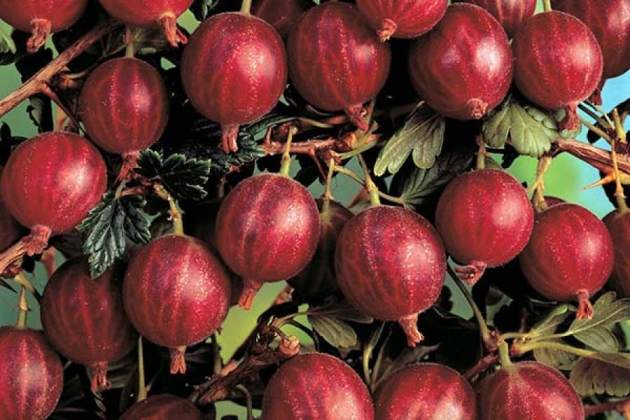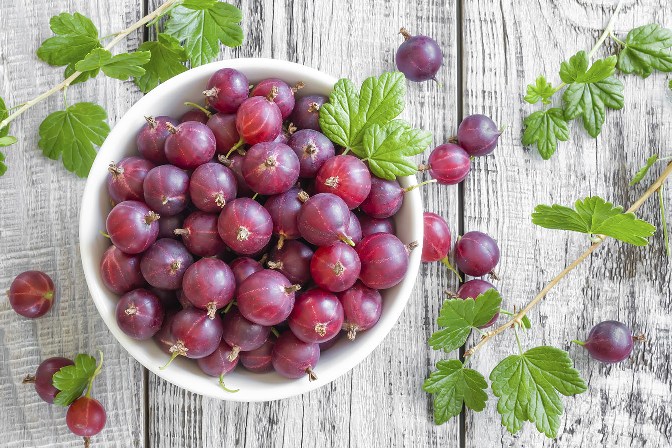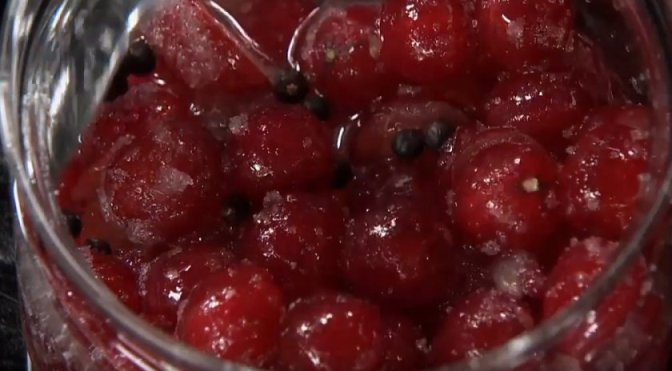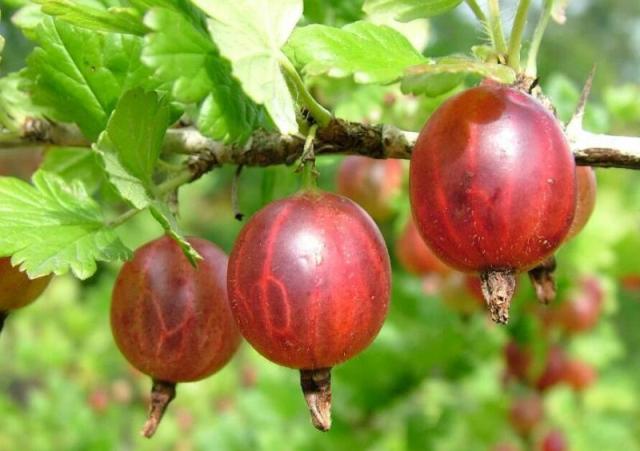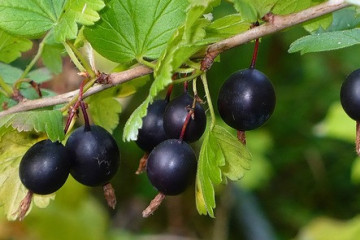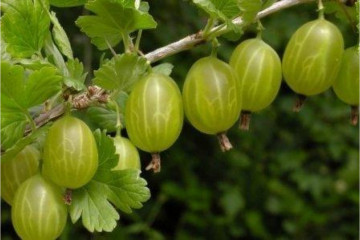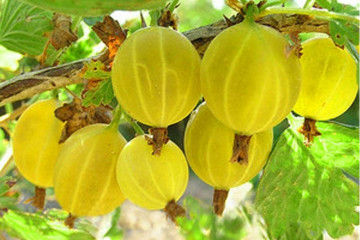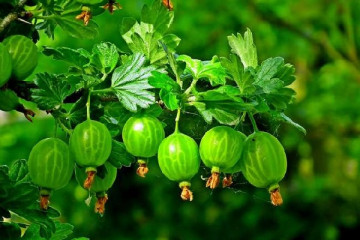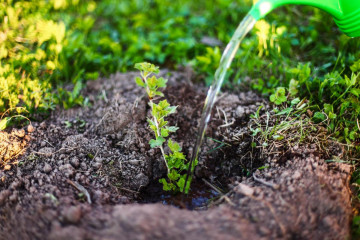Gooseberry Consul - features and characteristics of growing
Content:
Gooseberry Consul appeared about 30 years ago, but has already made itself known among fans of berry culture. The developed immune system, unpretentiousness to the ground and the absence of thorns attract amateur gardeners who are happy to take up the cultivation of the species.
Description and characteristics of gooseberry
The breeders were faced with the task of creating a gooseberry for growing in the harsh conditions of the Middle Strip. The experiment was successful. The parents of the hybrid were African and Chelyabinsk green. The resulting variety, Consul or Senator, was entered in the state register in 1995.
Characteristics of the bushes
Consul is a shrub 1.8 m high with a dense spreading crown. The branches of the hybrid are straight or slightly concave of medium thickness with a red-brown bark at the base. The root system of the variety is highly branched.
The leaves are bright green, small and wrinkled. The variety has few thorns. One or two thorns appear on annual shoots, but later disappear. Inflorescences are one-flowered and two-flowered.
Characteristics of berries
Gooseberries are medium-sized, rounded. Weight is 2.5-6.5 g. Bright red berries become burgundy when ripe. The skin is thin, vulnerable. The pulp is transparent and juicy. The berries taste sweet with a slight sourness.
Features of the variety
The consul (or Senator) gooseberry is convenient for growing on private farms. Even an inexperienced gardener can get a good harvest. And all because the variety does not need special care, takes up little space, is resistant to disease, drought and frost.
Ripening period and yield
Gooseberry Senator, according to the description, is a high-yielding variety. Observing the conditions of agricultural technology, up to 20 tons of berries are obtained from 1 hectare. From one bush, already in the first year of fruiting, 3 kg are removed per season. In the future, the yield increases.
In areas with a subtropical climate, gooseberries bloom at the end of May. Harvested from late July to mid-August. The berries are removed as they ripen.
Drought resistance and frost resistance
Gooseberry Consul is a frost-resistant plant. A temperature of −30 ° C is not terrible for a shrub. And early frosts are not critical for the Consul.
Disease and pest resistance
Due to the developed immune system, the Senator is indifferent to common diseases and garden pests. It does not suffer from powdery mildew, sawfly and septoria. And the attack of aphids and moths is stopped with natural preparations, without resorting to insecticides.
Taste qualities
Due to its taste, sweet and juicy pulp, thin skin, the berry is used in home cooking. Jam and jams are made from it, eaten fresh, compotes are rolled up. The berries are so vulnerable that they do not tolerate transportation well.Long distances are rarely transported and need quick home recycling.
Using berries
In cosmetology, gooseberry juice is used as masks for the skin against wrinkles and pigmentation. Traditional medicine is attracted by the composition of berries and the ability to help a person in the fight against diseases of the kidneys, liver and nervous system.
Advantages and disadvantages of the variety
Senator's Merits:
- high productivity;
- frost resistance;
- drought resistance;
- self-pollination;
- lack of thorns;
- good taste;
- disease and pest resistance;
- unpretentiousness to soil and care.
- versatility in use.
But there are also disadvantages:
- poor transport tolerance;
- hypersensitivity to winds and drafts;
- drought susceptibility.
As can be seen from the description of the variety, the consul gooseberry deserves attention and is grown not only in the Middle lane.
Planting young seedlings on the site
The best option for growing is ready-made seedlings.
Selection and preparation of seedlings
Planting material is bought in nurseries. Characteristics of seedlings:
- age not less than a year;
- roots are dense, without damage or signs of peeling;
- a two-year-old seedling has an earthen lump, a smooth root collar without signs of rotting and two or three branches with buds;
- one-year-olds have one shoot 10–15 cm long.
Landing time and pattern
Gooseberries are planted in early March, when the snow melts and the temperature reaches 4–6 ° C, or at the end of September, 1–1.5 months before the first frost.
Planting is carried out according to the scheme: a hole 50 × 60 cm.The distance between seedlings is 1.5 m.
Choosing a landing site
Consul bushes love sunlight, so the planting site is chosen on the south side in a calm area, since strong winds slow down the growth of seedlings.
Site preparation
The land for landing is selected loose, air-permeable. The culture gravitates towards medium loamy soils with an acidity index of up to 5.5 and groundwater at a depth of more than 2 m. A large accumulation of water is fraught with root decay.
Planting process
Algorithm of landing actions:
- Prepare the wells according to the scheme.
- Apply peat fertilizer or humus to the pits.
- Add 50 g of superphosphate and potassium salts.
- Clean the seedling from dry shoots, cut off the branches by a third.
- Place the seedling in the hole, straighten the roots.
- Sprinkle with soil, deepening the root collar by 6 cm.
- Tamp the soil with your hands.
- Pour half a bucket of settled water under the root.
- Mulch the soil with straw, pine needles, sawdust.
Before planting, the seedlings are kept for 2 hours in a growth stimulator.
Features of seasonal care
Watering and feeding
Over the summer, they are watered three times: at the beginning of flowering, during the ripening of berries and at the beginning of autumn. Liquid consumption 5 liters per bush. The ingress of water on foliage is excluded.
Gooseberry reacts positively to feeding. Fertilizers are applied three times per season:
- When the first leaves appear. Top dressing: 10 liters of water, 2 tbsp. spoons of nitrophoska, 1 tbsp. spoon of urea. A bush requires 15 liters of composition.
- During flowering. Solution: 10 liters of water, 1 tbsp. a spoonful of potassium sulfate, 2 tbsp. spoons of complex fertilizing for berries. 25 liters of the composition are consumed per plant, alternating with watering.
- At the stage of ovary formation. Ingredients: 10 liters of water, 1 tbsp. spoon nitrophoska, 2 tbsp. tablespoons of potassium humate. For one plant, use 30 liters of the mixture in several passes, alternating with watering.
Mulching and loosening
Twice a year, the soil around the gooseberry is dug to a depth of 10-15 cm. The trunk circle is loosened every 3-4 weeks.
Loosening is accompanied by mulching to retain moisture and prevent weeds. They use straw, manure, sawdust, leaves.
Using supports
Youngsters need props. Wooden stakes, a net dug into the ground will do. Structures protect branches from touching the ground and berry rotting. As the shrub grows older and grows, the branches are tied to supports.
Preventive treatment
Gooseberry Consul is resistant to pests and diseases. Therefore, for preventive measures, fungicides and insecticides are not used. Pruning and weeding is sufficient.
Pruning
The first pruning is done at planting. Bushes are freed from diseased and dry branches. Cut off the branches of the seedling by a third of the length.
Later, branches are cut off, overgrown and blocking the sunlight. After the procedure, the soil is loosened.
Preparing for winter
Gooseberries do not need winter shelter. List of winter preparations:
- sanitary pruning;
- spraying against pests;
- top dressing;
- disposal of garbage.
Reproduction
The variety propagates in two ways.
Cuttings
The procedure is carried out from July to the first days of autumn. A 15 cm long twig with two buds is cut from a branch and treated with a root growth stimulant. Then, at an angle of 45 °, it is introduced into the soil until the buds remain above the ground level. Water regularly.
Layers
To obtain seedlings, annual branches are bent to the ground, fixed with metal staples and sprinkled with earth. Water systematically. Rooted shoots are separated from the mother bush and planted in another place.
Pest and disease control
Gooseberry Consul sometimes needs protection from certain diseases and parasites.
How to help the culture:
- columnar rust and anthracnose. Spray before flowering and after harvesting with cuprozan or 1% solution of Bordeaux liquid;
- moth and gooseberry aphid. The drugs will help: inta-vir (dissolve 2 tablets in a bucket of water) or karbofos (60 g per 10 l of water);
- spider mite. It is cured by Aktelik, 2 ml of which is diluted in 2 liters of liquid. Due to the toxicity of the drug, another agent is used near water bodies.
Gooseberry Senator is convenient for growing at home due to its high yield, lack of thorns. The consul does not need pollinators, tolerates drought and frost well, does not require special care. Grown everywhere.
